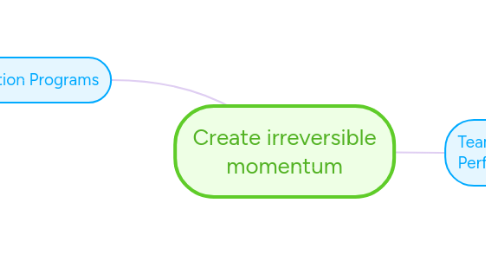
1. Teams from Storm to High Performance
1.1. the team has
1.1.1. overcome
1.1.1.1. skepticism
1.1.1.2. uncertainty
1.1.1.3. nonparticipativeness
1.1.1.4. dependence
1.1.1.5. self-centeredness
1.1.1.6. tendency to groupthink
1.1.2. developed
1.1.2.1. clear vision
1.1.2.2. personal commitment to the team
1.1.2.3. high degree of loyalty and morale
1.1.3. fostered
1.1.3.1. differentiation
1.1.3.2. variety
1.2. Attributes of high performing teams
1.2.1. Performance outcomes
1.2.2. Specific, shared purpose and vision
1.2.3. Mutual, internal accountability
1.2.4. Blurring of formal distinctions
1.2.5. Coordinated, shared work roles
1.2.6. Inefficiency leading to efficiency
1.2.7. Extraordinarily high quality
1.2.8. Creative continuous improvement
1.2.9. High credibility and trust
2. Effective Motivation Programs
2.1. When academics looks at motivation, many are taught the incorrect model
2.1.1. Incorrect: Satisfaction → Motivation → Performance
2.1.2. Correct: Motivation → Performance → Satisfaction
2.2. 1. Establish Clear Performance Expectations
2.2.1. Focus on the Motivation → Performance relationship
2.2.2. Ask: “Do subordinates understand and accept my performance expectations?”
2.2.3. Think effective goal setting and effective communications
2.2.3.1. *like how we talked about our goals and expectations at the beginning of this course)
2.2.3.2. SMART Goals and Everest goals
2.2.3.3. communicated goals
2.3. 2. Remove personal and organizational obstacles to performance
2.3.1. Focus on motivation- performance relationship
2.3.2. Ask: "“Do subordinates feel it is possible to achieve this goal or expectation?"
2.3.3. Think of checking in about resources and self-efficacy
2.4. 3. Use rewards and discipline appropriately to extinguish unacceptable behavior and encourage exceptional performance.
2.4.1. Focus on Performance → Outcome
2.4.2. Ask: “Do subordinates feel that being a high performer is more rewarding than being a low or average performer?”
2.5. 4. Provide salient internal and external incentives
2.5.1. Focus on Outcomes → Satisfaction
2.5.2. Ask: “Do subordinates feel the rewards used to encourage high performance are worth the effort?”
2.6. 5. Distribute rewards equitably
2.6.1. Focus on Outcomes → Satisfaction
2.6.2. Ask: “Do subordinates feel that work-related benefits are being distributed fairly?”
2.7. 6. Provide timely rewards and specific, accurate, and honest feedback on performance
2.7.1. Focus on Outcomes → Satisfaction
2.7.2. Ask: “Are we getting the most out of our rewards by administering them on a timely basis as part of the feedback process?”
2.7.3. Ask: “Do subordinates know where they stand in terms of current performance and long-term opportunities?”

